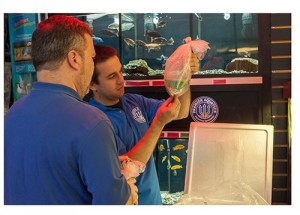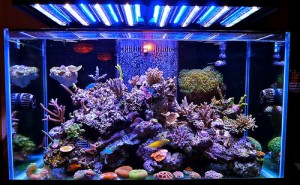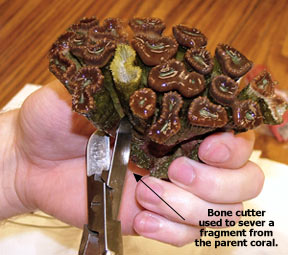 So it’s time to ring in the New Year. 2014 has been a year of great changes for the reef aquarium hobby. While change is neither inherently good, nor bad, the changes that have taken place this year in the hobby, may surprise some reef keepers. The Obama administration has proven to be one of the most aggressive in history, when it comes to preservation of the ocean. Not only has President Obama declared a large swath of sea a candidate as a marine protected area, under this administration NOAA has conducted research into just what is destroying the health of worldwide reefs and how commerce effects the ocean environment. The result for reefers is that our hobby has hit the radar, implicated as a potential cause of worldwide reef decline. NOAA identified 22 coral species (originally proposed 62 species) for the threatened species list, which could make them illegal to own, sell or trade in the future. While a reefer’s New Year’s resolution might be to obtain an exciting specimen, or upgrade a piece of equipment, in keeping pace with changing times, I offer the following resolutions to help make your aquarium more sustainable.
So it’s time to ring in the New Year. 2014 has been a year of great changes for the reef aquarium hobby. While change is neither inherently good, nor bad, the changes that have taken place this year in the hobby, may surprise some reef keepers. The Obama administration has proven to be one of the most aggressive in history, when it comes to preservation of the ocean. Not only has President Obama declared a large swath of sea a candidate as a marine protected area, under this administration NOAA has conducted research into just what is destroying the health of worldwide reefs and how commerce effects the ocean environment. The result for reefers is that our hobby has hit the radar, implicated as a potential cause of worldwide reef decline. NOAA identified 22 coral species (originally proposed 62 species) for the threatened species list, which could make them illegal to own, sell or trade in the future. While a reefer’s New Year’s resolution might be to obtain an exciting specimen, or upgrade a piece of equipment, in keeping pace with changing times, I offer the following resolutions to help make your aquarium more sustainable.
- Take a break from adding livestock
 One of the biggest thrills the hobby offers is the addition of something exciting to the aquarium. Though successfully adding a new tenant requires patience, observation and quarantine. Why not take a break from adding anything new. If a large percentage of aquarists did this, it would ease demand for livestock species harvested from the wild. Often it’s best to give a marine aquarium time to settle into being, allowing resident species to stake out a piece of the tank as their own, and adjust well to captive life. Adding something new upsets a balance that can take years to create. Sitting back, relaxing and enjoying what you have can allow your aquarium to become the blood pressure reducer marine tanks are famous for being.
One of the biggest thrills the hobby offers is the addition of something exciting to the aquarium. Though successfully adding a new tenant requires patience, observation and quarantine. Why not take a break from adding anything new. If a large percentage of aquarists did this, it would ease demand for livestock species harvested from the wild. Often it’s best to give a marine aquarium time to settle into being, allowing resident species to stake out a piece of the tank as their own, and adjust well to captive life. Adding something new upsets a balance that can take years to create. Sitting back, relaxing and enjoying what you have can allow your aquarium to become the blood pressure reducer marine tanks are famous for being.
- Re-evaluate feeding, and your protocol for keeping existing species healthy
 I often say that most marine fish are underfed, and the same can be said about corals and invertebrates. Many species in the wild are constantly feeding. Surgeonfish and angelfish graze non-stop, and mid water plankton feeders are always slurping up tiny particles. In reality, only predatory fish eat one large meal and then digest. The best possible feeding regimen is several small feedings per day, rather than one or two large meals. Be sure to feed a mixture of large, small and tiny items, ensuring minute invertebrates encrusted to live rock have something to eat.
I often say that most marine fish are underfed, and the same can be said about corals and invertebrates. Many species in the wild are constantly feeding. Surgeonfish and angelfish graze non-stop, and mid water plankton feeders are always slurping up tiny particles. In reality, only predatory fish eat one large meal and then digest. The best possible feeding regimen is several small feedings per day, rather than one or two large meals. Be sure to feed a mixture of large, small and tiny items, ensuring minute invertebrates encrusted to live rock have something to eat.
I personally feed LRS’s reef frenzy, herbivore frenzy and nano-frenzy during each feeding. This ensures that all my species get what they need, and the nano-frenzy offers food particles that are tiny.
Also, implement amino-acids, vitamins and other additives that increase the nutritional value of food. Mixing frozen foods with pellets is a good approach, as well as adding a plankton substitute for microscopic feeders. Nutrition is a top to bottom job, and your aquarium’s food chain is invaluable in keeping the entire system healthy, so make sure your feedings are appealing to all of it.
As for health protocol, using a UV sterilizer can ensure that built-up infectious bacteria or parasites are reduced in the water column. Your main focus however needs to be on water quality, as increased feedings raise the nutrient load throughout the tank. Researching new methods of reducing nutrient load (bio-pellets, zeolite, refugium) can be vital when feeding a lot.
- Take a look at your lighting schedule, settings
 If you’re not adding new livestock, why not focus some attention on what you already have. Many species of fish and corals appear totally different under various light spectrums. Many LED fixtures have a variety of settings, allowing you to appeal to specific color traits within your livestock. You may want blue areas to glow, or pull out the natural fluorescence within coral tissue. Finding a setting that not only makes your tank’s tenants look beautiful, but also provides fuel for photosynthesis takes time and tinkering. Once you have it, your tank inhabitants will appear totally different.
If you’re not adding new livestock, why not focus some attention on what you already have. Many species of fish and corals appear totally different under various light spectrums. Many LED fixtures have a variety of settings, allowing you to appeal to specific color traits within your livestock. You may want blue areas to glow, or pull out the natural fluorescence within coral tissue. Finding a setting that not only makes your tank’s tenants look beautiful, but also provides fuel for photosynthesis takes time and tinkering. Once you have it, your tank inhabitants will appear totally different.
As for your lighting schedule, consider adjusting it to cooperate better with your feeding routine. If you leave for work early, then have your lights kick on when you get home, giving you ample time to offer a handful of feedings. Marine livestock can adjust to nearly any 6-12 hour lighting schedule, so make your tank’s lights work with you, not against you.
- Get into fragging
 Fragging and trading corals doesn’t only relieve pressure on wild reefs, it’s a lot of fun. Fragging kits can be purchased for a reasonable price, and most of the other tools you’ll require can be found at the grocery or hardware store. Setting up a separate frag tank can allow you to offer corals the precise conditions under which to heal. Trading these with other reefers can keep a constant supply of captive grown livestock flowing through your tank. When I think about the long-term future of the hobby, fragging is it. The days of buying wild collected coral colonies for $ 500+ will only last so long, before no one can afford it or regulations prevent it. Fragging and trading what you already have with fellow aquarists is what will keep our hobby running, long into the future.
Fragging and trading corals doesn’t only relieve pressure on wild reefs, it’s a lot of fun. Fragging kits can be purchased for a reasonable price, and most of the other tools you’ll require can be found at the grocery or hardware store. Setting up a separate frag tank can allow you to offer corals the precise conditions under which to heal. Trading these with other reefers can keep a constant supply of captive grown livestock flowing through your tank. When I think about the long-term future of the hobby, fragging is it. The days of buying wild collected coral colonies for $ 500+ will only last so long, before no one can afford it or regulations prevent it. Fragging and trading what you already have with fellow aquarists is what will keep our hobby running, long into the future.
- Skip the forums, open a book or scientific paper
 Forums have become immensely popular within the hobby these days. Sadly though, many aquarists are using them as a sole source of information and livestock acquisition. This has the terrible side effect of promoting methodologies that may be incorrect, and are totally un-researched. There has been a sharp decline in publishing reef aquarium related books, largely because people have turned to forums for advice. Books are often the product of years of research, and consistent advice from professional aquarists and scientists. The value of knowledge you get from a reef keeping book is worth 100 times the value of a quick meme on a forum.
Forums have become immensely popular within the hobby these days. Sadly though, many aquarists are using them as a sole source of information and livestock acquisition. This has the terrible side effect of promoting methodologies that may be incorrect, and are totally un-researched. There has been a sharp decline in publishing reef aquarium related books, largely because people have turned to forums for advice. Books are often the product of years of research, and consistent advice from professional aquarists and scientists. The value of knowledge you get from a reef keeping book is worth 100 times the value of a quick meme on a forum.
All that time you gain by skipping out on forums, can be used to read scientific papers. Many marine science papers are available online. Some require a small payment to access, but having access to research outcome is invaluable. These papers are often written by a specialist in the field, or a doctoral candidate, and open up a host of ideas which can be implemented by aquarists.
- Know what you’re getting
Online, anything is for sale, including illegally caught fish and corals. I’ve seen coral collected from the China Sea for sale via online forums. It may seem harmless, but the import of animals from the China Sea is illegal, due to conservation restrictions. Keep yourself current with regulations and laws, and learn a bit about wild reef ecosystems, empowering yourself to make smart choices. This step can prevent you from inadvertently contributing to the illegal trafficking and sale of marine wildlife. Ignorance may be bliss, but it’s often self-imposed bad luck.
- Seek out a reef keeping club or local organization
These groups used to be the life blood of the hobby, bringing together aquarists for brainstorming sessions long before the internet had gained traction. If there isn’t a club in your area, talk with local fish outlets about starting one. Today it feels like this integral part of growing our hobby is dying out. There is no better place to swap advice, and a few frags, then a local reef keeping club. The major upside is that chicks go crazy for them!
- Remember that you can still use grey water
 The waste water created by your RODI unit isn’t really waste; in fact it’s perfectly fine. Harvesting that water and putting it to use somewhere else (washing machine, plant watering, etc) is a great way to relieve pressure from the environment. There are places right here in the U.S. where aquifer loss is leading to massive draughts. Even if there aren’t water problems in your neck of the woods, treating grey water as the precious resource it is helps contribute to an overall conservation of water resources.
The waste water created by your RODI unit isn’t really waste; in fact it’s perfectly fine. Harvesting that water and putting it to use somewhere else (washing machine, plant watering, etc) is a great way to relieve pressure from the environment. There are places right here in the U.S. where aquifer loss is leading to massive draughts. Even if there aren’t water problems in your neck of the woods, treating grey water as the precious resource it is helps contribute to an overall conservation of water resources.








0 Comments